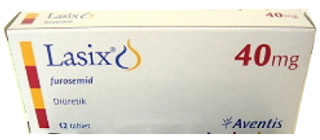Product Identification
Lasix is the brand name for the medication furosemide, which is a loop diuretic. Manufactured by Sanofi-Aventis, it’s used to treat edema and hypertension. Lasix has the FDA approval for medical use.
Pharmacological Class
Furosemide belongs to the pharmacological class of diuretics, specifically the loop diuretics. It acts on the ascending limb of the loop of Henle in the kidneys.
Indications for Use
Lasix is indicated for the treatment of edema associated with congestive heart failure, liver cirrhosis, and renal disease, including the nephrotic syndrome. It is also used for the treatment of hypertension either alone or in combination with other antihypertensive drugs.
Available Dosage Forms
Lasix is available in tablet form (20 mg, 40 mg, and 80 mg), oral solution form, and as an injectable solution for both intramuscular and intravenous administration.
Administration Guidelines
Lasix should be taken as prescribed by a healthcare provider. Tablets should be taken whole with a glass of water, without crushing or chewing. The injection forms are for professional use in healthcare settings.
Mechanism of Action
Furosemide inhibits the reabsorption of sodium and chloride in the proximal and distal tubules and the loop of Henle. This leads to increased excretion of water, sodium, chloride, magnesium, and calcium. The onset of action for oral Lasix is typically within 1 hour, with a peak effect at about 1 to 2 hours, and duration of action lasting for about 6 to 8 hours. For the injectable form, the onset is within 5 minutes with a peak effect by 30 minutes, lasting about 2 hours.
Dosing Information
The dosage of Lasix is individualized according to the patient’s medical condition, response to treatment, and the presence of any other medical conditions. For edema, the usual initial adult dose is 20-80 mg given as a single dose. Dosages may be adjusted incrementally up to 600 mg/day depending on the response. For hypertension, the average initial dose is 40 mg twice daily. For maintenance, dosage should be adjusted according to patient response.
Adjustments for Renal Impairment
In patients with impaired renal function, careful dosing and possibly lower dosages of Lasix are required since its effects may be potentiated.
Potential Drug Interactions
Concomitant use with aminoglycoside antibiotics increases the risk of ototoxicity. Nonsteroidal anti-inflammatory drugs (NSAIDs) may reduce the diuretic and antihypertensive effects of Lasix. Furosemide can enhance the effects of antihypertensive drugs, and concurrent use with lithium may lead to lithium toxicity. Combining Lasix with digoxin may increase the risk of digoxin toxicity.
Common Adverse Reactions
Common side effects include electrolyte disturbances, hypotension, light-headedness, headache, blurred vision, dizziness, and abdominal discomfort. Hearing impairment and tinnitus may occur, especially after intravenous administration.
Electrolyte Imbalance Monitoring
Furosemide can cause significant electrolyte depletion, particularly hypokalemia, hypomagnesemia, and hyponatremia. Monitoring of electrolytes is essential during long-term therapy or higher dosing. Periodic blood tests are recommended to monitor kidney function and electrolytes.
Guidance on Missed Doses
Should a dose be missed, it is advised to take it as soon as it is remembered. However, if it is close to the time for the next dose, the missed dose should be skipped, and the regular dosing schedule should be resumed. Do not double the dose to catch up.
Storage and Handling Instructions
Store Lasix at 77°F (25°C); excursions are permitted to 59–86°F (15–30°C). Keep the medication away from light and moisture, and out of reach of children and pets.
Pregnancy and Lactation Considerations
Lasix is classified as a pregnancy category C drug. It should be used during pregnancy only if the potential benefit justifies the potential risk to the fetus. Because it passes into breast milk, caution should be exercised when administered to a nursing mother.
Effects on Athletic Performance
Furosemide is on the World Anti-Doping Agency’s list of prohibited substances as its diuretic effect can mask the presence of other prohibited substances. Athletes should be aware of the implications of taking Lasix if they are subject to doping control.
Overdose Management
In the case of overdose, supportive and symptomatic treatment should be provided. This may include fluid replacement to address dehydration, management of electrolyte imbalances, and treatment of any associated hypotension.







Reviews
There are no reviews yet.